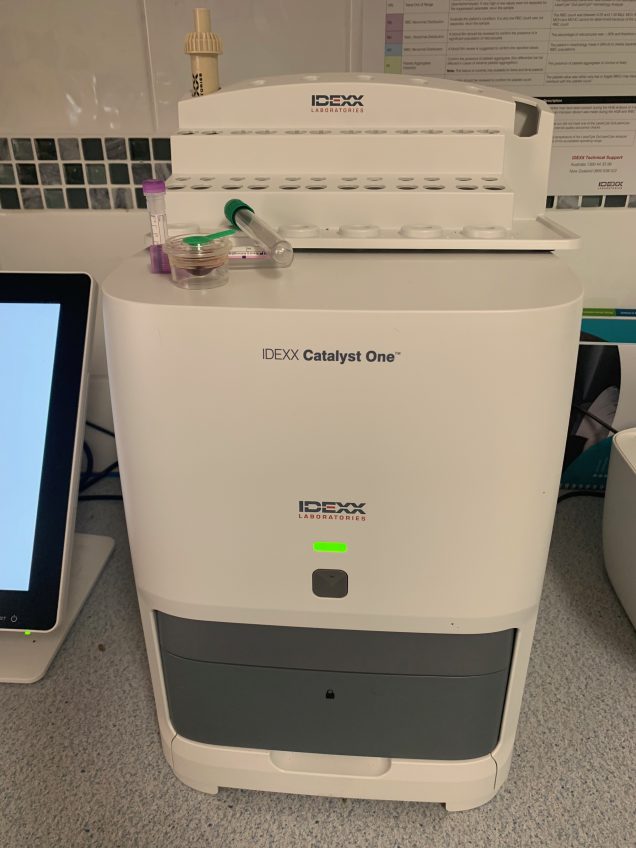Meet Zed. If he looks a bit guilty perhaps this is because he ate a few blocks of rat bait recently and made life difficult for himself and his family. With correct blood tests and treatment, Zed is feeling fine
Actually – questions about what to do when a dog or cat may have eaten rat bait, is a common one. So here is something to help you ….
What is in Rat Baits?
A compound called anti coagulants. Rat baits available in Australia cause death by bleeding. This is because they stop the animal taking rat bait to produce the clotting factors in liver that are required every day to stop the blood vessel damage that inevitably happens as part of life.
You may read on internet about Quintox, which WAS available in Australia. Quintox has not been sold here for over 20 years.
Treating animals poisoned by Quintox is virtually impossible, so we are thankful we no longer have it.
2 most common ratbaits aer RatSac or Brodifacoum/Difenacoum. This is important to be able to show your vet – how long treatment is needed for depends on which compound was in the rat bait your pet ate.
What does Rat Bait do?
Rat bait stops the production of clotting factors, therefore any small bleeds simply don’t stop.
The signs that develop in any dog or cat is dependent on where they are bleeding. Pale gums, swollen abdomen, swollen joints and bleeding into chest are amongst the more likely signs.
Does Rat Bait work quickly?
Rat baits are absorbed from stomach quickly, but physical signs may take 2-3 days or more to commence
Rat bait affects 4 clotting factors that your dogs liver makes.
Only when clotting factors reduce to a certain level, will time take for blood to clot be affected.
Changes in the time it takes blood to clot are detected via a specific blood clotting test called PT (prothrombin time) – however changes in this clotting test take at least 36 hours to show (but you dont know in most circumstances just when the dog took the rat bait, right?)
Time to Absorption
All rat baits are absorbed quickly from stomach. That means if it could be more than 2 hours since ingestion, you are wasting your time making dog or cat vomit
Lets face it – often you cant know just how long it has been, most people dont see the dog eat the rat bait, they just see the big teeth marks on bait and realise that wasnt the rat.
How Much Rat Bait is Fatal?
Depends on size of animal and how much rat bait is eaten.
Whilst calculators are available, it is often difficult to know with certainty just how much rat bait has been swallowed, and our suspicion is that we often underestimate how much your pet has eaten. I wont include the calculator here – your vet will have online access to them.
What can be done?
3 strategies – Vomit up the Rat Bait, do Blood Clotting tests or Use Vitamin K to stop the effects of Ratbait
There are generally 3 strategies that can be used:
- If you know with certainty rat bait was eaten within the last 2 hours, get the dog or cat to vomit. This is a job for vet clinic – the “recommended” agents for creating vomiting in pets at home are very unreliable in my experiences (peroxide, ipecac syrup). I suggest you dont try yourself – there is an injection that can be given to dogs that is very reliable in creating vomiting and then being able to assess whether rat bait was eaten
- If more than 2 hours after being eaten, we are wasting your time in making dog vomit. Depending on the time that has elapsed, using the prothrombin test can be useful. However remember that in first 36hours this is likely to be normal
- Use Vitamin K as antidote. The effects of Vitamin K are to compete with the rat bait and so manufacturing of the clotting factors recommences in a little as 6 – 12 hours after vitamin K is given. The type of rat bait your dog has eaten will determine how long the vitamin K is to be given for. Rat baits are stored in your dogs fat and liver after being absorbed and only very slowly eliminated from body (1 – 4 weeks for most available types) thus the vitamin k must be given for that long also.






